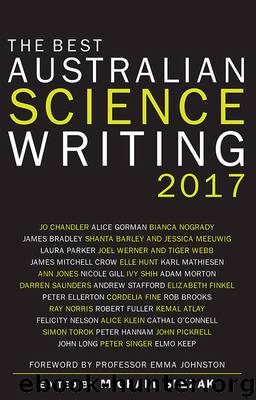The Best Australian Science Writing 2017 by Michael Slezak

Author:Michael Slezak
Language: eng
Format: epub
Publisher: University of New South Wales Press
Published: 2017-09-28T04:00:00+00:00
Counting birds to save the Murray–Darling
An island ark
Is it right to kill millions of animals if it protects others?
The big data telescope
Elizabeth Finkel
On a flat, red mulga plain in the outback of Western Australia, preparations are underway to build the most audacious telescope astronomers have ever dreamed of – the Square Kilometre Array (SKA). Next-generation telescopes usually aim to double the performance of their predecessors. The Australian arm of SKA will deliver a 168-fold leap on the best technology available today, to show us the Universe as never before. It will tune into signals emitted just a million years after the Big Bang, when the Universe was a sea of hydrogen gas, slowly percolating with the first galaxies. Their starlight illuminated the fledgling Universe in what is referred to as the ‘cosmic dawn’.
‘It is the last non-understood event in the history of the Universe,’ says Stuart Wyithe, a theoretical astrophysicist at the University of Melbourne in Australia.
Like any dream, realisation is the hard part. In 2018, when the first of 130 000 Christmas-tree–like antennae is deployed on the sandy plains of Murchison, an almost uninhabited district of 50 000 square kilometres, it will mark 28 years since its conception.
Epic battles have brought the project to this point – most famously the six-year contest between countries to host the telescope. Australia and South Africa ended up sharing the prize. The SKA’s telescope in South Africa will be built on another flat, red plain – the Karoo region of the Northern Cape. It has somewhat less lofty ambitions – its dishes will probe only halfway to the edge of the Universe. Its moniker, SKA-mid, denotes the midrange frequencies of radio waves stretched across this distance.
Australia’s SKA-low, by contrast, will tune into the low frequencies emanating from the extremities of the cosmos. Together the two telescopes will represent ‘the largest science facility on the planet’, says SKA director-general and radio astronomer Phil Diamond, who is based at Jodrell Bank Observatory in the UK.
The game-changing technology that will allow us to hear the whispers of newborn stars against the cacophony of the Universe doesn’t involve grinding mirrors to atom-thin smoothness or constructing dishes the size of sports fields. The disruptive technology here is supercomputing.
Once SKA-low is running, it will generate more data every day than the world’s internet traffic. Dealing with this deluge is a challenge being tackled by hefty global collaborations of academia and private enterprise – and it is by no means clear how it will be solved. ‘It’s a scale no one has attempted before,’ says Peter Quinn, a computational astrophysicist at the University of Western Australia, and director of the International Centre for Radio Astronomy Research (ICRAR) in Perth.
While international mega-science projects have been tackled before – think the European Organization for Nuclear Research (CERN), which operates the world’s largest particle accelerator, the Large Hadron Collider – when it comes to the SKA, the potential world-changing spin-offs have never been so blazingly obvious.
CERN didn’t just find the Higgs boson – computer scientist Tim Berners-Lee created the World Wide Web to manage its information sharing.
Download
This site does not store any files on its server. We only index and link to content provided by other sites. Please contact the content providers to delete copyright contents if any and email us, we'll remove relevant links or contents immediately.
Bad Pharma by Ben Goldacre(3396)
How To by Randall Munroe(3074)
The Book of Numbers by Peter Bentley(2928)
Aliens by Jim Al-Khalili(2802)
A Short History of Nearly Everything by Bryson Bill(2659)
The Meaning of it All by Richard Feynman(2318)
Bill Bryson by A short history of nearly everything(1692)
A Short History of Nearly Everything: Special Illustrated Edition by Bill Bryson(1648)
Elephants on Acid by Boese Alex(1578)
Six Easy Pieces by Richard P. Feynman(1506)
Everything in Its Place by Oliver Sacks(1467)
The Meaning Of It All by Richard P. Feynman(1430)
Glukhovsky, Dmitry - Metro 2033 by Glukhovsky Dmitry(1344)
Bad Science by Ben Goldacre(1311)
When Einstein Walked with Gödel by Jim Holt(1285)
The American Scene by Henry James(1228)
One Two Three ... Infinity: Facts and Speculations of Science by George Gamow(1226)
Leviathan Wakes by James S.A. Corey(1209)
A SHORT HISTORY OF NEARLY EVERYTHING by bryson bill(1193)
